How Much Does It Cost to Exterminate Flies?
Flies can be a major nuisance to homeowners. With over 16,000 species of flies in the United States alone, an invasion will occur at one point or another on your property. Although flies are usually not harmful, there are incidences of house flies that spread potentially serious diseases. For sanitary reasons, you should hire a fly exterminator as soon as you notice growing indoor populations.
Fly exterminator services cost around $175 to $300. The average homeowner will pay $250 to get rid of a large house fly infestation by a pest control company. An easier infestation such as fruit fly costs around $100 using traps. A large drain fly infestation treatment averages $375.
Fly Exterminator Cost
| Fly Pest Control | |
|---|---|
| National average cost | $250 |
| Average range | $175-$300 |
| Low-end | $100 |
| High-end | $375 |
In this guide
Fly Exterminator Cost by Type
Fly Pest Control Cost by Level of Infestation
Fly Exterminator Cost
Fly Control by Location
Signs of Fly Infestation
Are Flies Dangerous?
All About Flies
Where Do Flies Lay Eggs?
How to Prevent Flies
Additional Considerations
FAQs
References
Fly Exterminator Cost by Project Range
Fly Pest Control by Treatment
Fly pest control is a multi-step process. An exterminator arrives at your home for a detailed inspection, followed by a consultation that includes an estimated treatment price. The pest control specialist will recommend a treatment based on the type of fly and infestation size. For aggressive infestations, a combination of methods may be used. Homeowners may be advised to leave the property for two to four hours during any professional pest control treatment to limit chemical exposure.

| Treatment Method | Average Cost for 3-Bedroom House |
|---|---|
| Baits | $125 |
| Traps | $145 |
| Insecticide | $175 |
| Chemical Treatment | $250 |
Fly Baits
Fly baits use common attractants to kill flies instantly. The bait’s ingredients include pheromones, bright colors, and an alluring scent to attract flies. Commercial-grade fly baits should only be handled by a professional. The baits contain powerful agents that could harm humans or pets if not applied properly. The cost for professional fly bait treatment is around $125.
Fly Traps
Commercial fly traps are more effective than DIY types. A professional uses several types of fly traps. One type attracts flies with UV light before giving them a fatal shock. Another type features a gallon bucket with bait found inside. The flies can get into the bucket but are unable to escape. On average, expect to pay around $145 for fly traps set by a professional.
Fly Insecticide
Fly insecticides are also referred to as fly pesticides. The insecticides are applied as a spray, foam, or granules to the impacted area of the home or yard. Commercial products require that family members leave for several hours during treatment. The fly pesticides eliminate live flies and any eggs. Fly insecticide treatment starts at $175 for a three-bedroom home.
Chemical Fly Control
Chemical fly control features a more widespread application of insecticides. A common part of chemical fly control is fogging several areas where insect populations have invaded. Industrial foggers are used to apply an aerosol to a closed off area of the home. Fogger chemical treatment from a professional costs around $250 for three rooms of a home.
Fly Exterminator Cost by Type
Since there are over 16,000 species of flies, it’s difficult to cover all types of flies that you may encounter. Most homeowners that need an exterminator will identify the following types of flies. However, a more rare type, not included in the list, could occur.

| Type of Fly | Average Treatment Cost |
|---|---|
| Fungus Gnat | $100-$150 |
| Fruit Fly | $100-$175 |
| Blue Bottle Fly | $130-$200 |
| Soldier Fly | $140-$225 |
| House Fly | $150-$250 |
| Face Fly | $150-$300 |
| Phorid Fly | $155-$275 |
| Drain Fly | $170-$260 |
| Blow Fly | $180-$300 |
| Flesh Fly | $190-$275 |
| Sand Fly | $200-$375 |
| Horse Fly | $200-$400 |
| Cluster Fly | $225-$450 |
| Stable Fly | $300-$450 |
Fungus Gnats Control
Often confused with fruit flies, the fungus gnat is a type of pest that resides in houseplants. The flies are attracted to moist soil conditions and will breed inside the potted plant. Fungus gnats cannot be controlled using chemical treatments since this will likely kill the plants. Instead, baits are used to remove fungus gnats from the home. Professional removal costs from $100 to $150.
Fruit Fly Exterminator Cost
Fruit flies are very small, measuring less than ⅛” as adults. Their body is brown or gray. Fruits flies seek fermented fruit and vegetables as a breeding spot and commonly infest kitchens. Baits and traps are typical methods for removing fruit flies from a home. The average cost to get rid of fruit flies is between $100 and $175 for professional services.
Blue Bottle Fly Infestation
On average, a blue bottle fly measures ½” as an adult and has a distinct orange spot on the head and metallic blue coloring on the abdomen. The rest of the fly’s body is gray. Blue bottle flies tend to head indoors looking for food and shelter as the weather turns cooler. Pest control for blue bottle flies will be around $130 to $200 for insecticide applications.
Soldier Fly Infestation
Unlike most other common flies, a soldier fly has an appearance more like a wasp. These insects have a black or blue body with two transparent segments on its abdomen. As an adult, soldier flies have a significant length of ⅝.” The average cost to kill soldier flies by a professional will be around $140 to $225.
House Fly Infestation
The common housefly is the most frequent invader inside the home. House flies have a dull gray color and will only measure about ¼” as adults. Attracted to garbage and fecal matter, the flies breed on these items. House flies can be removed from a property through the application of traps, pesticides, and foggers. The cost to remove house flies is around $150 to $250.
Face Fly Control
Face flies are known to swarm in pastures and feed on animal feces. A face fly has a dark gray body with dark stripes. Adults measure around the same as a house fly—1/4.” Any type of homes with acreage are more prone to face fly infestations. The average cost to treat face flies is between $150 and $300.
Phorid Fly Extermination
Phorid flies have a very similar appearance to fruit flies, except for a humped back. Their coloring is black or brown with a measurement around ⅛.” Like drain flies, they breed within sewer pipes 1 and often infest bathrooms. The cost to exterminate phorid flies is around $155 to $275 for a professional to treat the home with baits and chemical treatments.
Drain Flies Pest Control
Drain fly extermination is important to take care of right away. Drain flies have fuzzy bodies with brown to black coloring. Drain flies can range in size, with most averaging between ⅙” and ¼.” The bugs are most common around pipes and drains and will invade kitchens and bathrooms. The average cost to remove drain flies from a home is $170 to $260 using drain chemical pesticides and baits.
Blow Flies Control
Among the easiest to identify, the blow fly has an unmistakable metallic blue or green body. The blow fly is slightly larger than a housefly and grows to ⅓” as an adult. Blow flies lay eggs in deceased animals, with the larvae feeding on the corpse. Blow fly extermination with pesticides and chemical treatments costs an average of $180 to $300.
Flesh Fly Control
Flesh flies have a gray or brown body and measure about ⅓” to ½.” Flesh flies seek out fecal matter or dead animal carcasses. The flesh fly may be attracted to a compost 2 bin. The average treatment for flesh flies costs $190 to $275, using a combination of baits and traps.
Sand Fly Control
A sand 3 fly is an extremely small fly with a hairy v-shaped body. This fly’s adult measurement is 1/10.” A sand fly feeds on blood and attacks humans, especially during the nighttime hours. Because of the sand fly’s small size, they are difficult to detect and challenging to exterminate. Sand fly control cost with a pesticide treatment ranges from $200 to $375.
Horse Fly Extermination
Horse flies are also known as deer flies and are large biting flies that feed on horses and other mammals. Horse flies reside near bodies of water since these are their breeding sites. Horse flies grow over an inch as an adult and have a gray or black body. Horse fly extermination costs range between $200 and $400 using traps and pesticides.
Cluster Fly Control
Frequently mistaken for the common house fly, cluster flies are also a well-known invader of properties. Cluster flies have black coloring with a checkerboard pattern on their mid-sections. They measure about ¼” when fully grown. Cluster flies swarm in groups, with populations getting large quickly. Since cluster fly infestations are hard to treat, the average costs range from $225 to $450 for pesticide control and chemical treatments.
Stable Flies Control
The stable fly’s appearance is closely related to the house fly. The stable fly has a gray body, but unlike the house fly, it has circular spots around the midsection. Adult flies measure around ¼” or slightly longer. Stable flies feed mostly on cattle and horses but can bite other animals and humans. The cost for stable fly removal will be around $300 to $450. According to the entomology department at the University of Florida, outdoor management of breeding sites and pesticides is necessary for stable fly removal.
Fly Pest Control Cost by Level of Infestation
The level of infestation impacts how much you pay to an exterminator. Call a pest control specialist at the first sign of flies growing in population. Flies breed at alarming rates and spread throughout your property. The following are the approximate costs based on the size of the swarm.

| Size of Infestation | Average Cost |
|---|---|
| Small | $100-$175 |
| Large | $200-$300 |
| Severe | $400-$600 |
Small Fly Infestation
Small fly infestations are normally limited to a single room or two of the home. The exterminator should treat the flies with traps or baits without the need for widespread pesticide applications. In most cases, a small fly infestation does not require a follow-up visit. The average cost to treat a small fly infestation is between $100 and $175.
Large Fly Infestation
With a large fly infestation, the flies have spread through multiple rooms of a home, and you may not know where the breeding grounds are located. With a large fly infestation, the pest control specialist needs to return at least once after the initial visit. Since a fly matures from egg to adult in ten days, follow-ups normally occur a week and a half to two weeks after the initial visit. The average treatment cost for large fly infestations is $200 to $300.
Severe Fly Infestation
Severe fly infestations occur when flies have spread throughout a home or property. The number of flies will be enough that the residence is uninhabitable until extermination efforts are completed. Multiple visits may be required. The treatment may require a combination of traps, pesticides, and chemical treatments to remove the flies from the property. The average cost for a severe fruit fly, house fly, or drain fly infestation is approximately $400 to $600.
Fly Exterminator Cost
Contact a professional at the first sign of a fly infestation. Professionals know how to identify the type of fly and the most effective treatments. For example, certain baits won’t work against species of fruit flies or drain flies. Most pest control professionals charge an initial visit fee between $50 and $100. Labor costs for severe infestations may be as much as $250 to $350 per visit. The average hourly wage for an exterminator is around $60 to $90 per hour. Inspection costs are included with the fee as long as you use the exterminator’s services. If you decide not to use the pest control company, the initial assessment fee maybe $50 or more.
Seasonal rates are usually not applied for fly control treatments. However, flies tend to head inside more often in the late fall as the weather cools. You may want to book your appointment in advance to confirm availability. Travel charges may apply with costs of $0.50 or more per mile outside the service area.
Pest control contracts are available that manage all insects and rodents on a property. If you choose to enter into a quarterly contract with the pest control company, you will be charged a reduced rate. Quarterly contracts with a pest control specialist cost approximately $150 per visit. Monthly contracts cost around $100 per visit, while an annual contract is approximately $200 per visit.

| Visits | Average Cost |
|---|---|
| One Time | $250 |
| Annual | $200 |
| Quarterly | $150 |
| Monthly | $100 |
Fly Control by Location
Fly extermination jobs are handled differently based on where the infestation is located. For instance, fly infestations inside the home are normally treated by a pest technician. Flies are almost impossible to remove completely outdoors. However, you can use treatments to reduce populations. Certain fly control products are less effective outdoors than indoors.
Fly Infestation in Kitchen
Fruit flies cause most fly infestations in a kitchen. Fruit flies are small-sized insects with light tan to brown coloring. The flies tend to feast on overripe fruit and other produce items. To prevent contaminating food and cooking items, pest control companies use baits and traps to remove flies from a kitchen instead of insecticides.
Fly Infestation in Yard
A fly infestation in a garden or yard may be difficult to manage, depending on the size of the treatment area. In most cases, you can treat your yard and lawn with pesticides to deter bugs. Mosquito control sprays ward off other flying insects, including flies.
Fly Infestation in Garage
Fly infestations in the garage can easily happen. The bugs enter through open garage doors and may be attracted by a certain odor. House flies commonly rest on garage surfaces such as walls and windows. Sprays, traps, and baits are all options to remove flies from a garage.
Fly Infestation in Basement
Fly infestations can grow quickly when located in a basement. Flies breed under concrete slabs 4 or in any pipes inside the basement. The insects may swarm in the basement due to a decaying animal, like a mouse. Fly infestations may be treated with insecticides, baits, and traps.
Fly Infestation in Bedroom
Most homeowners don’t want to deal with a fly infestation in a bedroom. If you’re noticing a large number of flies in the bedroom, it could mean that the flies are living behind the walls. To eliminate flies in the bedroom, a pest control contractor may drill a small hole and apply the pesticide through it to eliminate the flies.
Fly infestation in Bathroom
The plumbing in your bathroom is usually the cause of fly infestations. Drain flies, in particular, may swarm in bathrooms. The pest control technician may pour certain chemicals down the drain to stop drain flies from continuously entering the bathroom.
Signs of Fly Infestation
In most cases, a sign of a fly infestation is the sighting of visible flies in the home. You may notice the flies swarming around your trash bins, food items on counters, near windows, or by doors. A lone fly sighting isn’t a cause for concern. You should only worry if you see flies frequently and growing in number. Along with adult flies, you may find maggots around the property. Maggots hatch in pet bowls, feces, and rotting food items.
Along with living flies, you may see dark spots around the home. Black spots about the size of a pinhead are fecal matter left behind by the flies when they land. Single dots may be hard to see, but you may find clusters around the kitchen or near the windows.
Are Flies Dangerous?
The dangers associated with flies depend on the type found on your property. Certain flies, such as sand and stable flies, will bite both you and your pets. However, most bites are harmless and will not cause serious side effects. The greatest danger related to flies is food contamination. According to the World Health Organization, flies spread bacteria when they land on food items and can cause illnesses in people who consume the food.
According to the National Environmental Health Association, houseflies are considered the most dangerous fly due to the widespread nature of the insect. Pathogens associated with the housefly include e.coli, typhoid fever, and cholera. Additional fly species can spread diseases that include tuberculosis, dysentery, yaws, conjunctivitis, and poliomyelitis.

All About Flies
Flies are found in all areas of the world. Since there are so many fly species, it’s not uncommon to find close similarities in fly behavior and appearance. The fly life cycle starts with an egg before developing into a larvae. The larvae go through three stages 5 before entering into pupae. From the pupae emerges an adult fly. The entire fly life cycle spans between seven and ten days.
Flies taste with their feet. This is the reason they frequently land on food items. The fly regurgitates onto food items to break down the solid into a liquid that they can consume. Due to their fast digestive systems, they leave behind fecal matter each time they land.
Reproduction rates are staggering for a fly. A female fly can lay more than 2,000 eggs in a month. Most flies live up to a month, but lifespans are shortened without access to a reliable food and water source.
What Do Flies Look Like?
Most flies measure under one inch, with most adult flies being around ⅓” to ½.” Many flies have darkcolored bodies, composed of black and brown midsections. Some species have checkered or striped markings. Flies have wings, with most being transparent colored.
What Do Fly Eggs Look Like?
Fly eggs are very hard to spot. The eggs have the appearance of white grains of rice. Eggs hatch quickly, usually within one day. From the eggs, larvae appear and look like white worms. Larvae feed for about five days before transforming into pupae.
What Do Flies Eat?
Most adult flies feed on food items that are in the decaying process. Their diet may consist of decayed fruit, vegetables, meat, and even animal carcasses. Flies eat plant secretions and fecal matter. Flies don’t have teeth, so all food items are liquified before absorption.
What Attracts Flies?
Most flies are attracted to any type of rotting food or trash. They swarm near any kind of spills, such as fruit juices and soft drinks. Flies are also attracted to certain types of alcohol and overripe fruit. Heat is another attractant for flies. They look for moist, warm breeding grounds. Especially in the fall months, they seek shelter in a heated building. Interior and exterior lights attract flies. Their attraction to light is the premise for manufacturers to produce light traps. Animal feces attract flies since this is one of their breeding sites. Along with bird droppings, they look for dead animals for a breeding place.
Where Do Flies Lay Eggs?
Flies lay eggs in different areas based on their species. For example, fungus gnats lay their eggs in the moist soil of houseplants. House flies lay their eggs in decaying trash, feces, and even grass clippings. Fruit flies lay their eggs in fermented fruit items. A female blow fly lays eggs in animal carcasses. A flies nest is usually made up of hundreds of eggs, typically around 500 or more.
Fly eggs vary in shape and size, but most have a white to off-white color. The eggs are small and resemble a single grain of rice. Since eggs hatch quickly, usually within 24 hours, it's better to stop a fly infestation before breeding in the house.
How to Prevent Flies
Preventing flies is an important part of controlling populations in and around your home. To start, check access points around the exterior of the home. Flies get in from broken screens, openings around the doorframe, or an open window. Caulk 6 around door frames and window frames to prevent any insects from entering the home.
Clean up immediately after mealtimes. Never leave any food items uncovered and sitting out for a prolonged time—indoors or outdoors. Wipe down counter surfaces to remove any drink residue or food crumbs. When you take out the trash, put it in a sealed container. Garbage cans should be rinsed out routinely to keep them clean. Different color lightbulbs may repel flies. Consider a blue light or yellow light for your exterior lighting since the colors are known to deter flies.
Additional Considerations and Costs
- Licensed professionals. Any type of pest control company handles fly exterminations. Homeowners should confirm that the company has been licensed in the state.
- DIY. The homeowner could try DIY methods like fly swatters or tapes. However, these are not appropriate methods for a fly infestation. Instead, use DIY methods for a lone fly that has entered the home.
- Alternatives. Citronella candles help keep flies away since the bugs don’t like the smoke. If you have certain plants, including clove, lavender, and pine, the strong scent will naturally repel flies. A venus flytrap could also be used to catch flies in the home.
FAQs
- Can pest control get rid of flies?
Yes, a pest control company can use pesticides and chemical treatments to remove flies from a home.
- How long does fly infestation last?
A common misconception is that flies will only live for 24 hours. Mayflies are the only type with a 24-hour lifespan. Fly infestations can last until the life cycle is stopped. Current fly populations live an average of 8 to 12 days.
- How do I get rid of a fly infestation in my house?
Pest control specialists use baits, traps, and insecticides to kill flies, eggs, and larvae.
- How do I find the source of flies in my house?
Check for breeding spots around the home, including in houseplants, pet food bowls, garbage cans, drains, and pipes.
- What happens if a fly lays eggs in your food and you eat it?
You will not have any problems if you accidentally eat food with fly eggs on it. According to Penn State, the eggs die after you consume them.
References
- FIXR Cost Guides and Cost Database.
- NCBI. “A systematic review of human pathogens carried by the housefly (Musca domestica L.)."
https://www.ncbi.nlm.nih.gov/pmc/articles/PMC6104014/ - NEHA. “Common Housefly.”
https://www.neha.org/vector/common-housefly - Orkin. “Fly Facts & Information.”
https://www.orkin.com/flies - PennState Extension. “Questions and Answers about Flies and Ants."
https://extension.psu.edu/questions-and-answers-about-flies-and-ants - PestWorld.org. “House Flies.”
https://www.pestworld.org/pest-guide/flies/house-flies/ - Terminix. “How to Keep Flies Under Control.”
https://www.terminix.com/blog/diy/how-to-keep-flies-under-control/ - The Spruce. “How to Get Rid of Cluster Flies.”
https://www.thespruce.com/cluster-fly-description-2656663 - University of Florida Institute of Food and Agricultural Sciences. “Stable Fly - Stomoxys Calcitrans."
https://entnemdept.ufl.edu/creatures/urban/medical/stomoxys_calcitrans.htm - WHO. “Chapter 6: Houseflies."
https://www.who.int/water_sanitation_health/resources/vector302to323.pdf
Remodeling Terms Cheat Sheet
Definitions in laymen's terms, cost considerations, pictures and things you need to know.See full cheat sheet.
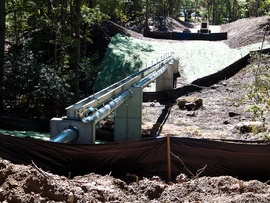 1 Sewer pipes: Principal pipe in a sewage system
1 Sewer pipes: Principal pipe in a sewage system
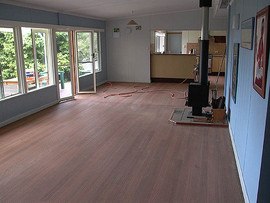 3 Sand: Process of removing the top surface of a material, such as wood, using sandpaper and/or a specialized sanding machine (for large surface areas)
3 Sand: Process of removing the top surface of a material, such as wood, using sandpaper and/or a specialized sanding machine (for large surface areas)
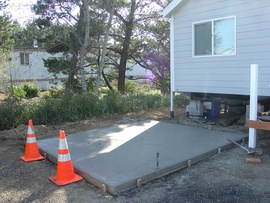 4 Concrete slabs: A flat area of concrete that can be used for a variety of purposes, such as a patio or a driveway
4 Concrete slabs: A flat area of concrete that can be used for a variety of purposes, such as a patio or a driveway
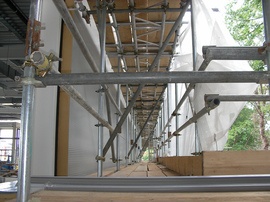 5 Stages: A temporary structure used during construction/maintenance/painting projects to raise and support workers (or one worker), required materials, and equipment
5 Stages: A temporary structure used during construction/maintenance/painting projects to raise and support workers (or one worker), required materials, and equipment
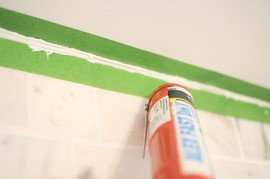 6 Caulk: A chemical sealant used to fill in and seal gaps where two materials join, for example, the tub and tile, to create a watertight and airtight seal. The term "caulking" is also used to refer to the process of applying this type of sealant
6 Caulk: A chemical sealant used to fill in and seal gaps where two materials join, for example, the tub and tile, to create a watertight and airtight seal. The term "caulking" is also used to refer to the process of applying this type of sealant
How much does it cost to exterminate flies in my city?
Cost to exterminate flies varies greatly by region (and even by zip code). To get free estimates from local contractors, please indicate yours.





